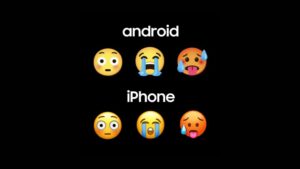Emojis became a universal language in digital communication. Whether to express emotions, reinforce the tone of a message or just to add a fun touch, they are present in almost all platforms and applications.
However, those who have already changed messages between different devices may have noticed a peculiarity: emojis do not always appear the same way for everyone.
Why does this happen? The answer involves standardization, visual interpretation and design decisions of each manufacturer.
What is an emoji?
Before understanding the differences, it is important to know what an emoji is. The term comes from the junction of the Japanese words “e” (image) and “moji” (character).
Created in the late 1990s in Japan, emojis are graphic symbols used to represent emotions, objects, places, symbols and more. Unlike emoticons (formed by character combinations, such as the traditional Smiley “=)”), emojis are coded images within a universal pattern.
Implementation of emoji
The technical basis of emojis is Unicode, an international standard that defines a specific code for each symbol, ensuring that the meaning is the same on all platforms.
However, Unicode does not define the look of each emoji, just what it represents. It is up to each operating system, application or website to decide how to display this symbol. Therefore, the same code can have very different appearances.
Google (Android and Chromeos)
Google uses the Noto Color emoji source to represent emojis. Since Android 4.3, users have had native support, which was expanded in the following versions. Companies like Samsung usually customize the drawings, creating their own style.
Apple (iOS and macos)
Apple introduced the emojis keyboard in Japan in 2008 and popularized it globally in iOS 5 in 2011. Since then, regular iOS and MacOS updates have brought new emojis with an exclusive design, famous for its most detailed and colorful style.
Microsoft Windows
Windows included colorful emojis from Windows 8.1, with the Source Segoe UI Emoji. With Windows 11, Microsoft has updated emojis to more modern and even 3D versions.
Mozilla Firefox
Firefox has opted for its own source, based on Twitter’s Twemoji project, ensuring that emojis are displayed even in systems that have no native support.
Linux
Distributions like Ubuntu and Fedora use the Noto Color Emoji source. In some cases, the user needs to install manually to support colorful emojis.
Social networks and other platforms
Twitter and Facebook, for example, use their own designs for their emojis, regardless of the user’s operating system. Twitter even offers the Twemoji package as Open Source.
read more
Reasons for the design differences of each manufacturer
Visual variations happen mainly for three reasons:
- Visual Identity: Each company seeks to create its own style, aligned with its brand identity.
- Cultural interpretation: Emotions and symbols can have different cultural interpretations. Companies adapt the designs to better reflect the understanding of their users.
- Technological Evolution: As new versions of Unicode leave, each manufacturer decides when and how to implement updates.











